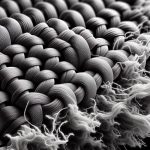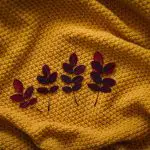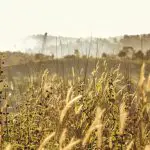When you’re working outdoors, your clothing takes a real beating—from rough plants to unpredictable weather. Choosing fabric that can handle wear and tear without sacrificing comfort is essential. You might assume denim or canvas are the go-to options, but there are other materials that offer unique advantages. Understanding which fabrics truly stand up to tough conditions can make a big difference in your daily workwear. Let’s explore what sets these materials apart.
Table of Contents
Key Takeaways
- Canvas and denim fabrics provide exceptional abrasion resistance and durability, ideal for heavy-duty landscaping workwear.
- Nylon and polyester offer high tear resistance and moisture-wicking properties, balancing strength with breathability for outdoor tasks.
- Ripstop fabrics prevent small tears from spreading, enhancing longevity in rugged working conditions.
- Neoprene adds water resistance and flexibility, suitable for wet or variable weather environments in outdoor work.
- Eco-friendly fibers like organic cotton, hemp, and recycled polyester combine durability with sustainability for long-lasting, responsible work clothing.
Characteristics of Durable Fabrics for Outdoor Work
When you work outdoors, your clothing needs to withstand tough conditions without wearing out quickly. You want fabrics that combine durability with comfort.
Outdoor work demands clothing that is both tough and comfortable, built to last through harsh conditions.
Look for materials with high abrasion resistance so they don’t easily tear or fray when you’re handling rough tools or brushing against branches. At the same time, fabric breathability is essential to keep you cool and dry during long hours in the sun.
Durable fabrics balance these traits by allowing air circulation while resisting wear and tear. When choosing your workwear, prioritize fabrics engineered to endure harsh environments yet provide enough ventilation to prevent overheating.
This combination helps you stay comfortable and protected, letting you focus on your landscaping tasks without worrying about your clothes falling apart.
Comparison of Popular Fabrics Used in Landscaping Clothing
Choosing the right fabric for landscaping clothing means understanding how different materials perform under tough conditions. You need fabrics that balance durability, comfort, and flexibility, especially with new fabric innovations and seasonal adaptations in mind. Here’s a quick comparison to help you choose:
| Fabric | Durability | Comfort | Seasonal Use |
|---|---|---|---|
| Polyester | High, abrasion-resistant | Lightweight, moisture-wicking | Great for warm seasons |
| Nylon | Very strong, tear-resistant | Smooth, breathable | Suitable year-round |
| Cotton Blend | Moderate, softer feel | Comfortable, breathable | Best in mild weather |
| Olefin | Durable, chemical-resistant | Cool, moisture-wicking | Ideal for hot climates |
Each fabric offers unique benefits. By considering these factors, you can pick clothes that last longer and adapt well to your work environment.
Benefits of Canvas and Denim in Tough Work Environments
Although synthetic fabrics offer many advantages, canvas and denim remain top choices for tough work environments because of their exceptional durability and resistance to wear.
When you choose canvas, you benefit from a heavy-duty weave that stands up to abrasion and punctures, making it ideal for various canvas applications like work pants and tool bags.
Denim, on the other hand, continues to follow denim trends that emphasize strength and comfort, providing you with rugged clothing that softens over time without losing toughness.
Both fabrics handle dirt and rough conditions well, so you won’t worry about frequent replacements.
Advantages of Ripstop and Polyester for Outdoor Durability
You’ll appreciate how ripstop fabric resists tears, keeping your gear intact during tough tasks.
Polyester’s quick-drying nature means you won’t stay damp after morning dew or sudden rain.
Plus, both materials offer lightweight durability, so you can move freely without sacrificing strength.
Tear Resistance Benefits
When you work outdoors, your clothing needs to withstand constant wear and tear. Ripstop and polyester fabrics offer exceptional tear strength, making them ideal for landscaping and other demanding outdoor tasks.
Ripstop’s unique weave prevents small tears from spreading, so your gear stays intact longer. Polyester adds durability by resisting abrasion and maintaining fabric integrity under stress. Together, these materials extend fabric longevity, meaning you won’t need to replace your work clothes as often.
You’ll appreciate how ripstop and polyester stand up to rough branches, sharp tools, and frequent movement without ripping or fraying. Choosing clothing made from these fabrics guarantees you stay protected and comfortable while working hard outside, saving you money and hassle over time.
Quick-Drying Performance
Because outdoor work often exposes you to moisture and sweat, quick-drying fabrics like ripstop and polyester keep you comfortable and dry throughout the day.
These materials benefit from advanced quick drying technologies that pull moisture away from your skin, allowing sweat to evaporate faster.
Thanks to their moisture wicking fabrics design, they prevent dampness that can cause discomfort or chafing during long hours outside.
Ripstop’s tightly woven fibers and polyester’s synthetic nature make them especially efficient at shedding water and drying quickly after rain or heavy perspiration.
When you choose clothing made from these fabrics, you stay cooler, reduce the risk of skin irritation, and maintain focus on your landscaping tasks without the distraction of wet, clingy clothes.
Lightweight Durability
Although lightweight fabrics often sacrifice strength, ripstop and polyester prove that durability doesn’t have to come with added bulk.
When you choose lightweight materials like ripstop, you get fabric woven with reinforced threads that resist tearing, giving you long-lasting wear without feeling heavy.
Polyester adds even more resilience, standing up to abrasions and harsh weather while remaining breathable.
These breathable options keep you comfortable during intense outdoor work by allowing moisture and heat to escape.
You won’t have to trade off comfort for toughness; ripstop and polyester combine the best of both worlds.
The Role of Neoprene in Weather-Resistant Workwear
You’ll appreciate how neoprene keeps you dry with its excellent water resistance, making it ideal for unpredictable weather.
It also offers great flexibility, so your movements won’t feel restricted during tough landscaping tasks.
Plus, its insulation helps maintain your body warmth, even when the temperature drops.
Water Resistance Benefits
When you face unpredictable weather while working outdoors, neoprene stands out as a key material that keeps you dry and comfortable. Its inherent water resistance, enhanced by waterproof coatings, prevents rain and moisture from soaking through your clothing. This means you can stay productive without worrying about getting damp or chilled.
Neoprene’s moisture management capabilities also help wick sweat away from your skin, maintaining a dry interior environment even during intense labor. Unlike other fabrics that absorb water and become heavy, neoprene remains lightweight and flexible, ensuring you move freely.
Flexibility and Insulation
Neoprene doesn’t just keep water out; it also offers remarkable flexibility and insulation that make your workwear ideal for unpredictable outdoor conditions.
When you’re working outside, you need fabric that moves with you without restricting your motions. Neoprene’s stretchy nature guarantees you stay comfortable during physical tasks, while its insulating properties help maintain your body heat in cooler weather.
Unlike some synthetic materials, neoprene balances thermal regulation with fabric breathability, preventing you from overheating or feeling clammy. This means you can rely on your clothing to keep you warm without sacrificing comfort.
Sustainable and Eco-Friendly Fabric Options for Work Clothing
Although durability remains essential, choosing sustainable and eco-friendly fabrics for landscaping work clothing greatly reduces environmental impact.
Durability is key, but eco-friendly fabrics significantly cut the environmental footprint of landscaping workwear.
You can support eco conscious manufacturing and sustainable materials without sacrificing toughness or comfort. Here are three top options to evaluate:
- Organic Cotton: Grown without harmful pesticides, organic cotton offers breathability and strength while promoting soil health.
- Recycled Polyester: Made from repurposed plastics, this fabric resists wear and tear and lowers landfill waste.
- Hemp: Naturally pest-resistant and requiring minimal water, hemp fibers create long-lasting, breathable workwear.
Frequently Asked Questions
How Do Durable Fabrics Affect Worker Safety on Landscaping Sites?
Durable fabrics boost your worker comfort by reducing wear and tear, letting you move freely. They also enhance injury prevention by providing better protection against cuts or abrasions, keeping you safer on landscaping sites.
What Are the Best Fabric Care Tips to Extend Workwear Lifespan?
You should use fabric maintenance techniques like gentle washing and avoiding harsh detergents. Also, implement proper workwear storage solutions, such as hanging clothes in a dry, ventilated area to extend your workwear’s lifespan effectively.
Can Durable Fabrics Cause Allergic Reactions or Skin Irritation?
Did you know 15% of people experience allergic reactions from certain fabrics? You might get skin irritation from dyes or synthetic fibers, so always check labels and choose hypoallergenic materials to keep your skin comfortable and safe.
How Do Fabric Choices Impact the Cost of Landscaping Uniforms?
You’ll find fabric types directly influence uniform pricing; durable, high-quality materials cost more upfront but save money long-term by lasting longer. Cheaper fabrics might lower initial costs but wear out faster, increasing replacement expenses.
Are There Specialized Fabrics for Landscaping in Extreme Climates?
Did you know 70% of outdoor workers prefer weather resistant materials? You’ll find specialized fabrics with moisture wicking technology that keep you dry and comfortable, even in extreme climates, making your landscaping work much easier.
- What Is Crypton Coconut Fabric? a Guide to Performance Textiles - June 29, 2025
- Removing Chewing Gum From Fabric Using Coconut Oil: Does It Work? - June 29, 2025
- Design and Fabrication of a Coconut Dehusking Machine: An Overview - June 29, 2025







